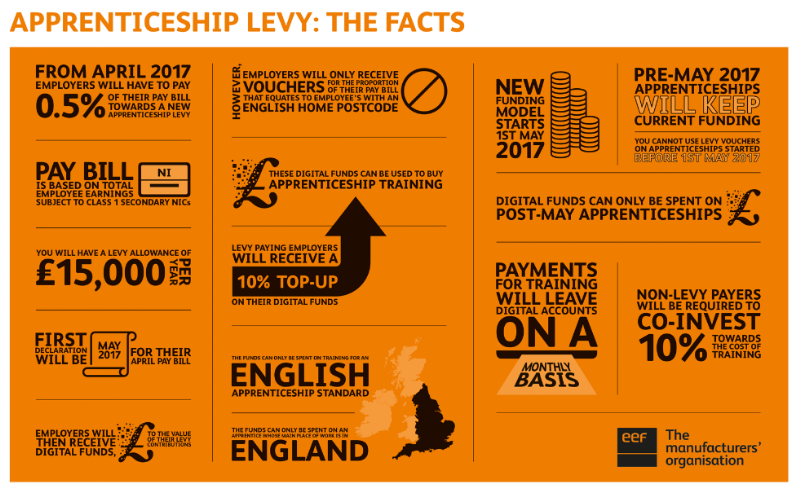14th March 2017 at 14:37
Apprenticeship Levy
Commencing 6th April 2017
The Apprenticeship levy requires all employers operating in the UK, with a pay bill over £3 million each year, to contribute 0.5% of their PAYE towards the Levy.
Employers who do not pay over £3 million per year will not
have to pay this Levy, but will still be subject to changes in the way
Apprenticeships are funded through the Digital Apprenticeship Service and will
also be eligible for up to 100% training subsidies for Apprenticeship training/
upskilling.

Key information about the Levy
The Apprenticeship Levy and how it will affect your company will
depend upon your existing PAYE bill, as I am sure you are aware if this figure
is above £3miliion then a tax Levy will be owed upon this amount and will be
automatically deducted via PAYE a monthly basis. These funds will be verified
by the government before being put into the organisation’s Digital Apprenticeship Service account, where the government
will top the contribution up by 10%. Levy payers are then able to use their pot
to pay for training - either by taking on an apprentice or upskilling their
existing staff. If you don’t use this money after 24 months, it’ll be removed from your account.
For workforces split across the UK the funding process will be slightly more complex as well as for groups of companies that are part of a larger organisation. We will be exploring this further in the NASS Apprenticeship Levy Seminar and you can find more information by following the link:
The
Apprenticeship Levy: Financial Advice for Group Organisations and Connected
Companies
Employers not paying above £3million in PAYE
If this figure is not above £3million then you will not be
required to pay this Levy and will not need to use digital vouchers to pay for
apprenticeship training and assessment until 2018 at the earliest. For now, the
government will pay training providers directly for these employers, however,
these employers will still need to choose a training provider from the
registered list, negotiate the cost of the training and adhere to the funding
caps for different qualifications, in the same way as larger firms that pay the
apprenticeship levy.
If you do not fall into the £3million requirement bracket there is also an opportunity under the new apprenticeship scheme for a co-investment arrangement with the government funding up to 90% of training for apprentices with 10% payable by the employer.
For employers with fewer than 50 employees (49 or fewer), will be eligible for The Apprenticeship Grant for Employers of 16- to 24-year-olds (AGE 16 to 24) where the government will fund 100% of the apprenticeship training costs, up to the maximum value of the funding band for the apprenticeship, if the apprentice is:
- aged between 16 and
18 years old (or 15 years old if the apprentice’s
16th birthday is between the last Friday of June and 31 August)
- aged between 19 and
24 years old and either has:
-
an education, health and care plan provided by the local
authority, or
-
has been in the care of the local authority
Employers eligible for the AGE 16 - 24 grant may also receive £1,500 for each eligible apprentice (up to five in total), where you have not employed an apprentice in the previous 12 months. To support apprenticeships in the most deprived areas, there will be a ‘disadvantage uplift’ of £600 for the 10% of most deprived areas, £300 for the next 10% and £200 for the next 7%. To support an apprentice with a learning disability, learning providers will be able to claim up to an additional £150 a month from the government. This amount could be increased if a greater level of learning support is needed.
The Government will fund apprentices to achieve GCSE
grade A* to C qualifications in English or maths (or both) if they do not
already meet the required standard. This will not be deducted from your digital
account or require employer co-investment. Under the Apprenticeship Levy, there are no barriers to eligibility
based on the qualifications of a potential candidate meaning employers can
utilise apprenticeship training, whether they’re taking on new entry-level staff, or seeking to upskill their
existing staff.
The minimum duration of an apprenticeship is one year unless the
framework or standard specification or assessment plan requires it to be
longer. The minimum duration of each apprenticeship is based on the apprentice
working 30 hours a week or more, including any off-the-job training they
undertake.
With the introduction of the Levy comes a range of new Trailblazer courses designed for employers, by employers - that aim to
better-meet an organisation’s needs and taking a tailored approach that actively matches its
workforce development goals.
Smaller employers will still need to register with the Apprenticeship
Account Service to procure their training and use the system to select an
appropriate apprenticeship from either existing SASE (Specification of Apprenticeship
Standards for England) frameworks or the new Trailblazer standards, which are
being rolled out to replace them.
The Apprenticeship Account Service will also contain a register
of approved training providers, which are the only organisations that can be
used to procure Levy-funded training. All of the new Trailblazer standards will
require an end-point assessment organisation to be appointed, which is procured
via a register, similar to that of training providers.
Once these steps are complete, you will be able to post
apprenticeship vacancies online (if required) or undertaking training for
existing staff.


Paying the apprenticeship levy
Accessing your levy money using the apprenticeship
service
Employers who operate in England and other parts of the
UK
Buying apprenticeship training and assessment
What you can spend apprenticeship funding on - all
employers
Eligibility for training and assessment




